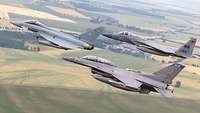The German Air Force and its closest ally: Cooperation with the USUnited States Air Force
History- Date:
- Place:
- Alaska
- Reading time:
- 3 MIN


The Cold War between the United States and the Soviet Union between 1947 and 1991 resulted in a profound change within the armed forces: With the increasing importance of strategic air warfare, air forces operating within the Alliance became a central element of deterrence and defense.

The close cooperation between the German Air Force and the USUnited States (United States) Air Force created a legacy that can be felt still today. It also contributes to consolidating transatlantic cooperation in air defense and aviation security.
Bundeswehr/Christian TimmigIn the first years after World War II, Germany was subject to severe restrictions in terms of military activities. However, with the Cold War beginning and NATONorth Atlantic Treaty Organization established in 1949, the Western Allies considered it necessary to let Germany rearm. And so, in 1955, the Bundeswehr was founded, including its own air forces. The USA as the leading force within NATONorth Atlantic Treaty Organization played a decisive role in the development and training of the German air forces.
During the 1950s and 1960s, it was clearly noticeable how closely the German Air Force and the USUnited States (United States) Air Force were cooperating. The two air forces adapted their training programs in order to establish mutual standards and procedures. Not only did this facilitate interoperability but also promote a strong sense of togetherness between pilots and support personnel. Pilot and SAM training programs took place throughout the USA at up to 15 garrisons. Training of German personnel in the USA went beyond the mere imparting of flying skills and technical capabilities. It also fostered the formation of international networks and collaborations. The prospective pilots, for example, established contacts with their USUnited States-American fellows. This strengthened the relations between the two nations and later facilitated cooperation in multinational deployments and exercises.
The threat posed by the Soviet Air Force resulted in an increased number of combined operations and maneuvers of the German Air Force and the USUnited States Air Force. Combined exercises such as “Reforger” (Return of Forces to Germany) were crucial to enhance the effectiveness of NATONorth Atlantic Treaty Organization’s armed forces and simulate possible scenarios in the event of a conflict.
Technological progress was crucial during the Cold War, and the USA played a key role in modernizing the German Air Force. The provision of modern aircraft, such as the F-104 Starfighter, and advanced technologies helped strengthen the capabilities of the German air forces and increase their efficiency.
Another important aspect of cooperation was the combined responsibility for airspace surveillance. The integration of AWACSAirborne Early Warning and Control System (Airborne Early Warning and Control System) into the armed forces of the two nations considerably enhanced the early warning capacities and contributed to ensuring airspace security.
With the end of the Cold War, the geopolitical conditions changed drastically. The threat posed by the Soviet Air Force was no more and the partnership between the German Air Force and the USUnited States Air Force evolved from one that met the requirements of the Western military alliance to collaboration and cooperation in various international missions and peacekeeping operations.
The close cooperation between the German Air Force and the USUnited States Air Force during the Cold War created a legacy that can still be felt today. The common traditions established during this period of time not only shape our bilateral relations but also contribute to consolidating transatlantic cooperation in air defense and aviation security.
by Thomas Skiba